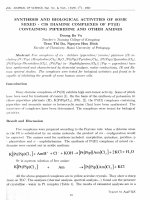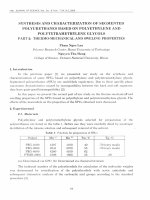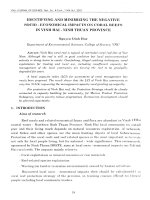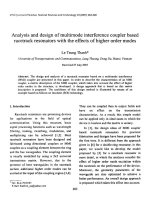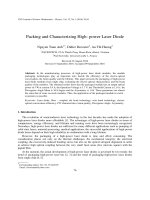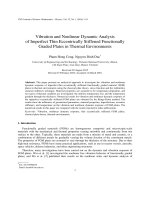DSpace at VNU: Concurrent and Longitudinal Correlation Between Children’s Emotional Reactivity, Regulation and Adjustment
Bạn đang xem bản rút gọn của tài liệu. Xem và tải ngay bản đầy đủ của tài liệu tại đây (100.29 KB, 9 trang )
VNU Journal of Science: Education Research, Vol. 31, No. 4 (2015) 45-53
Concurrent and Longitudinal Correlation Between Children’s
Emotional Reactivity, Regulation and Adjustment
Trần Thành Nam*
VNU Institute for Education Quality Assurance,
6th Floor, C1T Building, 144 Xuân Thủy Str, Cầu Giấy, Hanoi, Vietnam
Received 02 February 2015
Revised 26 February 2015; Accepted 22 December 2015
Abstract: This paper describes a study using two different samples to examine concurrent and
longitudinal relations between children’s emotional reactivity, regulation and adjustment. Fortyeight children from preschool through second grade were recruited to provide data on concurrent
relations between regulation, reactivity and adjustment (sample 1). And forty kindergarten children
were recruited and assessed at 2 time points to provides longitudinal relations (sample 2).
Emotional reactivity and regulation were assessed during home visits using the same series of
disappointment tasks, questionnaires and coding system. In sample 1, teachers completed a
problem behavior checklist at the same time with the home visit. In sample 2, teachers completed
the checklist two years after home observation. Results indicate that the dysregulation of sadness is
associated with internalizing behavior concurrently, and that the dysregulation of anger is
associated with externalizing problems two years later. Children’s anger reactivity is associated
with both concurrent and later externalizing problems.
Keywords: Anger, sadness, regulation, reactivity, adjustment.
1. Introduction *
psychological problems, including poor social
competence [6], depression [13, 25], anxiety
[23], and aggressive behavior problems [9,
14]. While most studies focus on children’s
regulation of generalized distress, few studies
differentially examine negative emotions and
their relations to adjustment. In response, the
current study examines the regulation of
anger and sadness specifically in relation to
adjustment problems in early childhood.
Moreover, this study examines patterns of
regulation and reactivity observationally.
In a growing number of studies across
disciplines, problems in emotion regulation
have been linked to the development of
adjustment problems in children [10, 18].
Children who display high levels of negative
emotions, such as anger and sadness, are
more likely to be aggressive and to suffer
from a broad range of psychological problems
[12]. Problems in regulating negative
emotions have also been linked to a variety of
_______
*
are
Tel.: 84-912013831
Email:
45
Emotion regulation and emotional reactivity
highly related constructs. Emotional
46
T.T. Nam / VNU Journal of Science: Education Research, Vol. 31, No. 4 (2015) 45-53
reactivity refers to the intensity of the
individual’s emotional response, whereas
emotion regulation refers to the processes
involved in initiating, maintaining, and
modulating this response [28, 11]. Negative
emotional reactivity represents the child’s
tendency to react to stressors with high degrees
of emotional intensity, including anger,
irritability, fear, or sadness [21]. Children who
are high in negative reactivity and low in their
ability to regulate negative emotions are at risk
for developing both externalizing and
internalizing problems [10]; however, most
research to date on this topic utilizes parent or
teacher reports of reactivity and regulation. [21]
Although negative reactivity and regulation
are frequently studied as a global higher-order
construct [26], recent findings on temperament
and physiology suggest that sadness, anger, and
fear are sub-served by different neurological
substrates [5, 7] For example, anger appears to
be regulated by an approach system, whereas
fear and sadness are regulated by a withdrawal
system; and activity in these systems are likely
related to different outcomes [21]. Rothbart,
Ahadi, and Hershey (1994) found that in 6- to
7-year-old children, the regulation of fear and
sadness were related to prosocial, but not
antisocial outcomes, whereas the regulation of
anger was predictive of aggression and
antisocial activity, but not prosocial outcomes
[20]. Rydell, Berlin, and Bohlin (2003) found
that both anger and fear were related to
prosocial behavior in their study of 5-to-8-yearold children. However, only anger was
predictive of externalizing problems across
contexts, while fear acted as the sole predictor
of internalizing behavior problems [24].
In terms of psychopathology, irritability,
frustration, and angry outbursts are common
characteristics of individuals diagnosed with
conduct disorder, whereas the presence of
persistent and frequent sad or anxious affect are
hallmark features of depressive and anxiety
disorders [2]. In line with this observation, there
is some evidence that susceptibility to anger
and frustration may be more strongly related to
externalizing problems [10, 24], whereas
susceptibility to fear, anxiety, and sadness may
be more strongly related to internalizing
problems [17, 18, 24]. Others, however, have
found more generalized and nonspecific links
between emotion regulation and adjustment.
For example, Silk et al. (2003) found that
among adolescents, dysregulated anger and
sadness were each associated with both
internalizing and externalizing problems [25].
Similarly, Zeman et al. (2002) found that
dysregulated anger and sadness were each
predictive of children’s internalizing problems
[30]. Gilliom et al. (2002) found that the ability
to appropriately utilize different regulatory
strategies in response to anger was the most
important predictor of externalizing behavior
problems [14].
In sum, there is mixed evidence for the
proposition that internalizing and externalizing
difficulties are differentially related to patterns
of emotional reactivity and regulation.
Consequently, the current study examines how
different types of emotional reactivity (anger
and sadness) and their regulation are linked to
internalizing and externalizing difficulties. The
study extends extant knowledge by examining
reactivity and regulation observationally in
young children. Few studies examine reactivity
and regulation observationally, with most
current research relying on parent or teacher
reports [24].
The current study replicates study design
and procedures of Morris, 2010. We also utilize
two samples in order to examine concurrent and
T.T. Nam / VNU Journal of Science: Education Research, Vol. 31, No. 4 (2015) 45-53
longitudinal relations among constructs. We
hypothesized that anger reactivity and anger
dysregulation would be associated with higher
levels of externalizing problems both
concurrently and longitudinally, and that
sadness reactivity and dysregulation would be
associated with higher levels of internalizing
problems both concurrently and longitudinally.
2. Method
2.1. Participants
Sample 1. Children were recruited from
public elementary schools. The sample included
48 children (23 girls, 25 boys; M age = 7 years,
1 month) ranging in age from 5.58 to 8.58
years. Fourteen of the children were in
kindergarten or pre-kindergarten, with the
remaining children in either first or second
grade. Sixteen percent of mothers reported
some high school education or having
completed high school; 65% reported
completing some college; and 17% reported
completing college or some post college
education. Data from this sample were used to
analyze concurrent associations between
regulation/reactivity and adjustment.
Sample 2. Children were recruited using the
same procedures as in Sample 1(from public
kindergarten). All of the children were in prekindergarten or kindergarten at the initial
assessment. Parents of children were contacted
two years later when children were in 1st or 2nd
grade, and with parental permission, data were
collected from teachers on children’s
adjustment. Forty-eight percent of the original
sample consented for teacher participation in
1st-2nd grade. This sample included 40 children
(20 girls, 20 boys; M age = 5 years, 1 month at
Time 1). ANOVAs revealed no significant
47
differences on any of the study variables for
participants who ended participation and those
who continued participation in 1st-2nd grade.
Thus, all analyses focused on children with data
from both time points. Ten percent of mothers
reported completing some high school
education or having completed high school;
77% reported completing some college; and
12% reported completing college or some post
college education. (See table 1 for more
demographic and background characteristics).
Data from this sample were used to calculate
the
longitudinal
associations
between
regulation/reactivity and adjustment.
2.2. Procedure
These samples were participants in a larger
investigation examining the role of the family
in the development of psychopathology during
early childhood. Data were collected during 1.5
to 2-hour home visits (using Affect Coding
Scale of Hubbard and AFFEX Coding System
of Izard, Doughtery & Hembree). Each motherchild dyad engaged in a series of tasks designed
to assess parent-child interactions. Mothers
were told to interact with their children as they
normally would. Families were paid
200.000VND for their time. With parental
permission,
teachers
were
mailed
questionnaires to assess the child’s behavior
in school. In Sample 1, teachers were mailed
Ontario Child Health Study Scales soon after
the home visit (to assess the concurrent
relationship). In Sample 2, children’s
teachers were contacted 2 years after the
home visit to complete Ontario Child Health
Study Scales. Data from this sample is used
to report longitudinal relationship between
Children’s Emotional Reactivity, Regulation
and Adjustment.
T.T. Nam / VNU Journal of Science: Education Research, Vol. 31, No. 4 (2015) 45-53
48
Table 1: Demographic and background characteristics
Sample 1
Concurrent Assessment
N
% female
48
47%
Age mean (year/month)
7/1
Mother level of education
% graduated high school
% completing college
% post college education
Marital status
Married and living together
Divorced
Occupational status
Employed outside the home
Working at home
Unemployed
Number children in family (mean, SD)
Monthly household monthly
(mean /mil. VND)
Sample 2
Longitudinal
Assessment
40
50%
Time 1: 5/1
Time 2: 7/1
16%
65%
17%
10%
77%
12%
92.6%
4.3%
96%
4.5%
86.2%
9.3%
2.0%
1.6(.6)
84.1%
12%
2.3%
2.2(.9)
12.2
13.2
d
2.3. Measures
Emotional Reactivity and Regulation.
Emotional reactivity and regulation were coded
from a three-minute disappointment task in
which a child is given an unwanted prize. This
task was adapted from Cole (1986) [8].
However, the procedure was modified to
include the assessment of emotion regulation
with the parent present. In this task, a child is
given a prize that he or she had previously
ranked as the worst prize out of 10 potential
prizes (e.g., broken sunglasses, socks, a broken
toy). An examiner gives the prize to the child in
a paper bag while the child is seated at a table
with his or her mother. The child then opens the
bag and sees the toy, and the parent-child
interaction is observed. After three minutes,
both examiners return to the room and resolve
the situation by explaining that a mistake was
made and the wrong prize was given to the
child. The child is then given the opportunity to
choose another prize.
During each 10-second interval of the task,
the intensity of anger and sadness displayed by
the child were coded on a five-point scale, with
a five indicating the highest degree of the
expressed emotion, and a one indicating that the
emotion was not expressed. Anger and sadness
intensity were each coded according to the
child’s facial expression, tone of voice, and
nonverbal emotional behaviors. Specific
guidelines for emotion coding were adapted
from Hubbard’s (1997) Affect Coding Scale,
and Izard, Doughtery, and Hembree’s AFFEX
Coding System (1983) [15, 16]. Reliabilities for
sadness and anger in the current samples were
acceptable (anger, kappa = .71 and r = .82;
sadness, kappa = .70 and r = .80). Data on
emotional expression/intensity were averaged
across intervals in order to obtain separate
sadness and anger reactivity ratings. Children’s
sadness and anger regulation were calculated
as the duration of the expressed emotion (see
Thompson, 1990) [27]. Specifically, regulation
T.T. Nam / VNU Journal of Science: Education Research, Vol. 31, No. 4 (2015) 45-53
was computed by counting the number of
intervals an emotion was expressed starting
from the beginning of the task until the emotion
subsided. Intervals were counted until the child
had a “one” for at least one interval, indicating
that for at least 10 seconds, there was no sign
of the emotion. Thus, higher scores indicated
higher levels of dysregulated affect. There
was 100% agreement for anger and sadness
duration variables.
Internalizing and Externalizing Problems.
Teacher report of problem behavior was
assessed via a modified version of the
internalizing and externalizing scales of the
Ontario Child Health Study Scales (OCHS;
Boyle, Offord, Racine, Szatmari, & Sanford,
1993) [4]. The OCHS assesses problem
behavior symptoms associated with DSM-III
childhood psychiatric disorders and contains
items adapted from the Child Behavior
Checklist (CBCL; Achenbach & Edelbrock,
1981) [1]. The OCHS has good internal
consistency,
test-retest
reliability,
and
agreement with psychiatrists’ diagnoses [4].
The modified OCHS contains 35 symptom
items rated on a Likert-type scale ranging from
0 (rarely applies) to 2 (certainly applies).
Broadband scales are computed to assess
internalizing (e.g., worries about things in the
future; needs to be told over and over that
things are okay) and externalizing (e.g., kicks,
bites, or hits other children; defiant, talks back
to adults) symptoms. Chronbach’s Alphas in the
current study ranged from 0.95 to 0.78.
3. Results
Means and standard deviations for the study
variables are presented in Table 2. Mean
49
differences for all the study variables were
examined with respect to maternal education
level, child sex, child age. A significant mean
difference was found for internalizing in Study
1, where girls (M = .54, SD = .27) displayed
higher levels of internalizing compared to boys
(M = .37, SD = .29; F = 4.00, p < .05);
however, all patterns of relations held after
controlling for sex in regression analyses, and
there was no significant sex by emotion
interactions suggesting that relations among
emotion regulation/reactivity and adjustment
were the same for boys and girls. It should also
be noted that in both studies, children displayed
significantly higher levels of sadness reactivity
and dysregulation than anger reactivity and
dysregulation, respectively (t’s ranged from
4.01 to 34.59; see Table 2 for means and
standard deviations).
Pearson correlations were calculated to
examine linear relations among constructs (See
Table 2 below). Contrary to expectations,
children’s sadness reactivity was not associated
with teacher report of internalizing problems in
either study. However, children’s sadness
dysregulation was associated with teacher
report of internalizing concurrently (sample 1),
but this association was not found
longitudinally. As hypothesized, children’s
observed anger reactivity was associated with
higher levels of teacher reported externalizing
behavior concurrently (sample 1), and two
years later (sample 2), suggesting that anger
reactivity is both a correlate and predictor of
externalizing problems. Anger dysregulation
was associated with teacher report of
externalizing behavior only in the longitudinal
study (sample 2).
50
T.T. Nam / VNU Journal of Science: Education Research, Vol. 31, No. 4 (2015) 45-53
Table 2. Correlation Matrix and Descriptive Statistics for Major Variables
__________________________________________________________________________________________
Variable
1
2
3
4
5
6
Min
Max
Mean
SD
__________________________________________________________________________________________
SAMPLE 1 – Concurrent Associations
1. Anger Reactivity
1.00
1.00
3.67
1.43
.55
2. Anger Dysregulation
.83*** 1.00
0.00
15.00
2.44
3.62
3. Sadness Reactivity
.15
.04
1.00
1.50
4.59
2.52
.56
4. Sadness Dysregulation
-.05
-.10
.51***
1.00
1.50
15.00
12.42
4.12
5. Externalizing Problems
.31*
.17
-.01
.23
1.00
.00
1.65
.35
.42
6. Internalizing Problems
-.07
-.17
.14
.33*
.21
1.00
.00
1.07
.44
.29
_________________________________________________________________________________________________________________
SAMPLE 2 – Longitudinal Associations
1. Anger Reactivity
1.00
1.00
4.44
1.38
.68
2. Anger Dysregulation
.94*** 1.00
0.00
15.00
2.47
3.60
*
.37
.25
1.00
1.23
4.18
2.60
.71
3. Sadness Reactivity
4. Sadness Regulation
.24
.14
.72**
1.00
3.00
15.00
12.20
4.30
.37*
.40*
-.19
-.19
1.00
.00
1.51
.26
.34
5. Externalizing Problems
6. Internalizing Problems
-.13
-.09
-.21
-.13
.34* 1.00
.00
1.36
.39
.33
_________________________________________________________________________________________________________________
Note: *p < .05, **p < .01, ***p < .00
4. Discussion
Children who displayed more intense anger
in response to a structured task designed to
induce disappointment were, according to their
teachers, more likely than their peers to display
externalizing problems in school. Additionally,
children who experienced more intense anger
and difficulty regulating this anger tended to
exhibit higher levels of externalizing difficulties
two years later. Consistent with research on
impulsivity, poor attentional abilities, and
“under-controlled”
temperament
(Belsky,
Hsieh, & Crnic, 1998; Rubin, Hastings, Chen,
Stewart, & McNichol, 1998), this study found
that anger reactivity and dysregulation are both
associated with externalizing problems,
implicating anger control as an important target
of intervention work aimed at reducing
aggressive behaviors [3, 23].
children to experience internalizing problems,
such as depressed affect and anxiety [30].
However, sadness reactivity and regulation
were not related to internalizing problems two
years later. Consistent with Eisenberg et al.
(2001), but in contrast to other recent studies
(Silk et al. 2003; Zeman et al. 2002), links
between emotion dysregulation and adjustment
followed
specific
pathways.
Sadness
dysregulation was uniquely related to
internalizing problems, and anger dysregulation
was uniquely related to externalizing problems
[25, 30, 10]. These discrepancies in findings
across studies may be partly attributable to
differences in methodology, as most studies that
have failed to show specific links between
emotion type and adjustment relied primarily
on child report of emotion dysregulation, in
contrast to the observational approach used in
the present study.
The study also provides some support for
the role of sadness dysregulation in
internalizing problems. In line with Zeman et
al. (2002), children who displayed difficulty
regulating sadness were more prone than other
Several potential limitations to this study
should be noted. First, both samples in this
study were relatively small and provided only
modest power to detect small to moderate
effects. Second, the task used in this assessment
T.T. Nam / VNU Journal of Science: Education Research, Vol. 31, No. 4 (2015) 45-53
was
designed
to
elicit
children’s
disappointment. It is unclear whether children’s
responses would generalize to other contexts,
and future research should consider using a
range of tasks. Third, mothers were present
with children during the disappointment task.
Although the mothers’ presence increases the
ecological validity of the task, since parents are
often present during real-life emotional
scenarios, their involvement potentially
confounds children’s own efforts to regulate
their emotions with their parents’ attempts. An
important strength of this study is the use of
independent informants for all of the constructs
of interest (teacher report of internalizing and
externalizing problems, observer report of
emotion regulation), which minimizes shared
informant bias and helps maintain the
independence of constructs. Another strength of
the current study is the observational method
used to assess emotion regulation. Most
previous research on emotion regulation in this
age group has relied on parent and teacher
reports of children’s emotionality and emotion
management [21]. Moreover, observational
studies of emotion regulation typically have
examined children’s overall emotional distress
or negativity, and not the specific emotion
expressed or the dynamics of emotional
expression [29].
Although we did find evidence linking
reactivity and regulation to child adjustment,
several hypotheses were not supported.
Surprisingly, anger regulation was not related to
externalizing problems concurrently; even
though it was related to externalizing problems
two years later, and anger reactivity was
associated with externalizing problems
concurrently. Moreover, it should be noted that
anger dysregulation and reactivity are highly
correlated in both samples, suggesting that there
51
may be little difference among these constructs
as they were empirically assessed in the present
study. In contrast, sadness reactivity and
regulation were only moderately correlated in
both samples. Nevertheless, anger and sadness
regulation and reactivity had different patterns
of associations with adjustment, suggesting the
value of assessing these constructs separately.
The lack of associations between sadness
reactivity and concurrent internalizing was also
unexpected, as were the lack of associations
between sadness reactivity and regulation with
internalizing problems two years later. This
lack of association may be partly related to the
use of teachers as reporters of children’s
internalizing. Although young children’s
externalizing symptoms are usually obvious in a
classroom setting, children’s internalizing
symptoms pose less of a problem for teachers and
are less overt. Multi-reporter assessments of
children’s internalizing symptoms, including
parent and child report, may be helpful in
clarifying the relation between emotion regulation
and internalizing problems in future studies.
References
[1] Achenbach, T. M., & Edelbrock, C. S.,
Behavioral problems and competencies by
parents of normal and disturbed children aged
four through sixteen, Monographs of the
Society for Research on Child Development,
46 (1981) 1.
[2] American Psychiatric Association, Diagnostic
and statistical manual of mental disorders (4th
ed.). Washington, DC: Author, 1994.
[3] Belsky, J., Hsieh, K. H., & Crnic, K., Mothering,
fathering, and infant negativity as antecedents of
boys' externalizing problems and inhibition at
age 3 years: Differential susceptibility to rearing
experience? Development and Psychopathology,
10 (1998) 301.
[4] Boyle, M. H., Offord, D. R., Racine, Y. A.,
Szatmari, P., & Sanford, M., Evaluation of the
revised Ontario Child Health Study scales.
52
[5]
[6]
[7]
[8]
[9]
[10]
[11]
[12]
[13]
[14]
[15]
[16]
T.T. Nam / VNU Journal of Science: Education Research, Vol. 31, No. 4 (2015) 45-53
Journal of Child Psychology & Psychiatry and
Allied Disciplines, 34 (1993) 189.
Buss, K. A., & Goldsmith, H. H., Fear and anger
regulation in infancy: Effects on the temporal
dynamic of affective expression. Child
Development, 69 (1998) 359.
Calkins, S. D., Gill, K. L., Johnson, M. C., &
Smith, C. L., Emotional reactivity and emotional
regulation strategies as predictors of social
behavior with peers during toddlerhood. Social
Development 8 (1999) 310.
Carver, C.S., Negative affects deriving from
the Behavioral Approach System. Emotion, 4
(2004) 3.
Cole, P. M., Children's spontaneous control of
facial expression. Child Development, 57
(1986) 1309.
Cole, P. M., Teti, L. O., & Zahn-Waxler, C.,
Mutual emotion regulation and the stability of
conduct problems between preschool and early
school age. Development and Psychopathology,
15 (2003) 1.
Eisenberg, N. Cumberland, A. Spinrad, T. L.,
Fabes, R. A., Shepard, S. A., Reiser, M., et al.,
The relations of regulation and emotionality to
children’s externalizing and internalizing
problem behavior. Child Development, 72
(2001) 1112.
Eisenberg, N., & Morris, A. S., Children’s
emotion-related regulation, In H. Reese & R.
Kail (Eds.), Advances in Child Development and
Behavior, 30 (2002) 189.
Frick, P. F., & Morris, A. S., Temperament and
developmental pathways to conduct problems.
Journal of Clinical Child and Adolescent
Psychology, 33 (2004) 54.
Garber, J., Braafladt, N., & Weiss, B., Affect
regulation in depressed and nondepressed
children and young adolescents, Development &
Psychopathology, 7 (1995) 93.
Gilliom, M., Shaw, D. S., Beck, J. E.,
Schonberg, M. A., & Lukon, J. L., Anger
regulation in disadvantaged preschool boys:
Strategies, antecedents, and the development of
self-control. Developmental Psychology, 38
(2002) 222.
Hubbard, J. A., Observing children's emotion
expression in peer interaction in a confederatebased, competitive paradigm. Paper presented at
the Society for Research in Child Development
biennial meeting, Washington, DC, 1997.
Izard, C. E., Doughtery, L., & Hembree, E., A
system for identifying affect expressions by
[17]
[18]
[19]
[20]
[21]
[22]
[23]
[24]
[25]
[26]
[27]
holistic
judgments
(AFFEX).
Newark:
Instructional Resources Center, University of
Delaware, 1983.
Kagan, J., & Fox, N. A., Biology, culture, and
temperamental biases. In N. Eisenberg (Ed.),
Handbook of child psychology: Vol. 3. Social,
emotional and personality development (6th ed.,
pp. 167-225). New York: Wiley, 2006.
Morris, A. S., Silk, J. S., Steinberg, L., Sessa, F.
M., Avenevoli, S., & Essex, M. J.,
Tempermental vulnerability and negative
parenting as interacting of child adjustment.
Journal of Marriage & Family, 64 (2002) 461.
Morris, A. S., Steinberg, L., Sessa, F. M.,
Avenevoli, S., Silk, J. S., & Essex, M. J.,
Measuring
children’s
perceptions
of
psychological control: Developmental and
conceptual considerations. In B. K. Barber (Ed.),
Intrusive Parenting: How Psychological Control
Affects Children and Adolescents (pp. 125-159).
Washington, DC: American Psychological
Association Press, 2002.
Rothbart, M. K., Ahadi, S. A., & Hershey, K. L.,
Temperament and social behavior in childhood.
Merrill-Palmer Quarterly, 40 (1994) 21.
Rothbart, M. K., & Bates, J. E., Temperament.
In N. Eisenberg (Ed.), Handbook of child
psychology: Vol. 3 Social, emotional and
personality development (6th ed., pp. 99-166).
New York: Wiley, 2006.
Rubin, K. H., Coplan, R. J., Fox, N. A., &
Calkins, S. D., Emotionality, emotion regulation,
and
preschoolers'
social
adaptation.
Development and Psychopathology, 7 (1995) 49.
Rubin, K. H., Hastings, P., Chen, X., Stewart, S.,
& McNichol, K., Intrapersonal and maternal
correlates of aggression, conflict, and
externalizing problems in toddlers. Child
Development, 69 (1998) 1614.
Rydell, A. M., Berlin, L., & Bohlin, G.,
Emotionality, emotion regulation, and adaptation
among 5- to 8-year-old children. Emotion, 3
(2003) 30.
Silk, J. S., Steinberg, L., & Morris, A. S.,
Adolescents' emotion regulation in daily life:
Links to depressive symptoms and problem
behavior. Child Development, 74 (2003) 1869.
Tellegen, A., Watson, D., & Clark, L. A., One
dimensional and hierarchical structure of affect.
Psychological Science, 10 (1999) 297.
Thompson, R. A., Emotion and self-regulation.
In R. A. Thompson (Ed.), Socioemotional
development, Vol. 36: Nebraska Symposium of
T.T. Nam / VNU Journal of Science: Education Research, Vol. 31, No. 4 (2015) 45-53
Motivation (pp. 367-467). Lincoln: University of
Nebraska Press, 1990.
[28] Thompson, R. A., Emotion regulation: a theme
in search of a definition. In N. A. Fox(Ed.),
Monographs of the Society for Research in Child
Development (Serial No. 240 ed., Vol. 59, pp.
25-52). Chicago, IL: University of Chicago
Press, 1994.
53
[29] Walden, T. A., & Smith, M. C., Emotion
regulation. Motivation and Emotion, 21(1)
(1997) 7.
[30] Zeman, J., Shipman, K., & Suveg, C., Anger and
sadness regulation: Predictions to internalizing
and externalizing symptoms in children. Journal
of Clinical Child and Adolescent Psychology, 31
(2002) 393.




